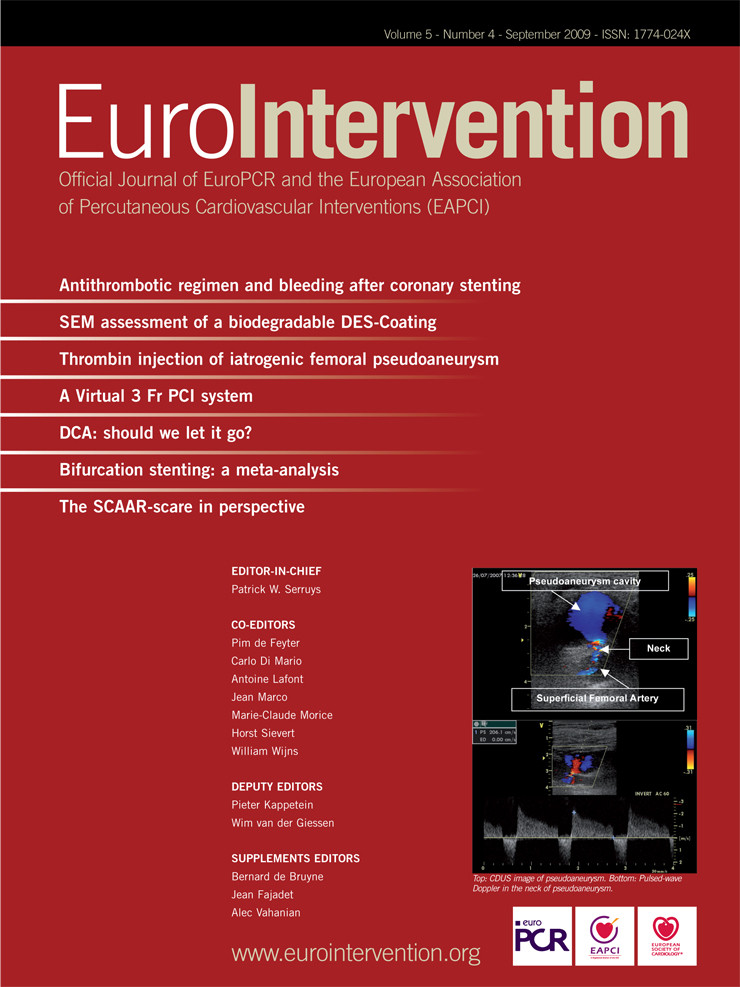Drug eluting stents (DES) have offered a convincing answer to the problem of in-stent restenosis1,2. However, the risk of stent thrombosis associated with those devices3 has led to the recommendation of prolonged dual antiplatelet therapy4,5. An increasing number of patients under oral anticoagulants are treated with stents and have therefore a potential indication for triple antithrombotic therapy. This may, in turn, increase the risk of major bleeding which is associated with worse short- and long-term clinical outcomes6. The optimal trade-offs in terms of prevention of thrombosis and bleeding in this setting remain unclear.
In this issue of EuroIntervention, Hälg et al, based on the BASKET (BAsel Stent Kosten Effektivität Trial) Trial7, describe early and late major bleeding complications (as defined by the ISTH criteria) in a cohort of 813 patients undergoing PCI with stents (DES and bare metal stents). The authors report a major bleeding rate of approximately 6%, evenly split between early and late bleeding. Importantly, approximately 5% of the patients from their cohort were on chronic oral anticoagulants, in addition to standard antiplatelet therapy, with a 6-month overlap between dual antiplatelet therapy and chronic anticoagulants. In that subset, the risk of late bleeding was considerably increased as compared to patients without anticoagulants, with an odds ratio of 9. The authors appropriately emphasise that this should lead to caution in the use of DES in patients who require chronic oral anticoagulants.
The data currently available to guide clinicians in this particular setting of stent placement in patients who require chronic anticoagulation is still scarce8 and, considering the growing number of patients under oral anticoagulants requiring angioplasty, the results of this study, particularly the magnitude of the bleeding risk, are of immense clinical interest. There are, however, several limitations that must be highlighted. First, the sample size remains small (813 patients) leading to a limited number of bleeding events (50). In turn, the statistical power available for analysis of the determinants of bleeding is also limited. In addition, the demonstration that a high bleeding rate occurs in patients on oral anticoagulants receiving drug eluting stents is important, but only indirectly addresses the issue of stent selection in these patients. The authors did not show a lower bleeding risk with bare metal stents, and there is still some uncertainty as to how much of the excess risk of bleeding with triple antithrombotic therapy occurs early rather than late after stenting. If the excess bleeding occurs early, one would expect that even with bare metal stents, a short course of triple antithrombotic therapy of a few weeks would still result in high bleeding rates. If, on the contrary, the excess risk of bleeding occurs late or is constant over time, then any strategy which shortens the duration of triple therapy would be expected to reduce bleeding. In that respect, it is important to keep in mind that the authors did not actually show that late bleeding events were indeed more frequent in patients with DES. Therefore, their data only indirectly supports their conclusion that drug eluting stents should be used cautiously in patients on oral anticoagulants.
The bleeding risk of patients under triple antithrombotic therapy is an issue of increasing concern. First, while there is solid data to support that dual antiplatelet with aspirin and a thienopyridine is very effective in preventing stent thrombosis, it is not entirely clear how much aspirin contributes to this effect. This is important, because it is conceivable that the use of aspirin might be obviated and that patients with oral anticoagulation could be treated with dual antithrombotic therapy (combining warfarin and a thienopyridine) rather than triple therapy with added aspirin. Potentially, this may help reduce the bleeding risk. Observational data from a small series suggests that this may be possible9. Since patients on oral anticoagulants are generally excluded from randomised controlled trials testing stenting strategies, most of the information available stems from registries and confirms that triple antithrombotic therapy is associated with a high bleeding risk. There are several potential important implications: First, it is important to weigh the benefits and risks of using drug-eluting stents in patients who have an indication for chronic oral anticoagulation. In these patients, given the high bleeding risk of protracted triple antithrombotic therapy with aspirin, a thienopyridine and oral anticoagulation, it may be wise to use solely bare metal stents, which allow us to use a short course of thienopyridine. Whenever the patient and lesion characteristics put the patient at very high risk of restenosis (such as multiple long lesions in short vessels in diabetics), alternative revascularisation with coronary artery bypass grafting should be seriously considered. Secondly, in order to better assist the proper selection of the revascularisation technique, an individualised estimation of bleeding risk would also be useful: in those patients at lower risk of bleeding, selective use of drug eluting stents may be possible, whereas it would appear unwarranted in patients identified, a priori, as being at high risk of bleeding. Finally, strategies to mitigate the bleeding risk, particularly preventing upper gastrointestinal tract bleeding, are important10. While there are serious concerns that omeprazole11 – and possibly other proton pump inhibitors12 – may interfere with the efficacy of clopidogrel, other agents, such as famotidine13 may be very effective in preventing aspirin-induced bleeding without these side effects. Clearly, there is a whole avenue for research on this topic.

